The sound of the party filters across the mansion's lawn long before you see it: Dozens of guests spill out onto the front porch of the stately Fendall Hall in Eufaula, Alabama.
It's an engagement party, and past the people drinking white wine in the main hall is one of the home's historians, Susan Campbell.
She swings open the door to the expansive backyard.
"They had, like, 5 acres or so," Campbell says of the former owners, the Young-Dent family. They built the house in the late 1850s.
But you might already know this, because planted in the front yard of this historical home is a large, black-and-gold, square metal historical marker with the seal of the Alabama Historical Commission — and it says so.
Edward Brown Young was a "banker, merchant and entrepreneur," it says. He "organized the company which built the first bridge" in Eufaula, and his daughter married a Confederate captain in the "War Between the States."
What the marker doesn't mention, however, is that Young was a cotton broker, one of the most powerful men in the slave trade. Nor does it mention that he owned nine slaves, according to the federal 1860 census.
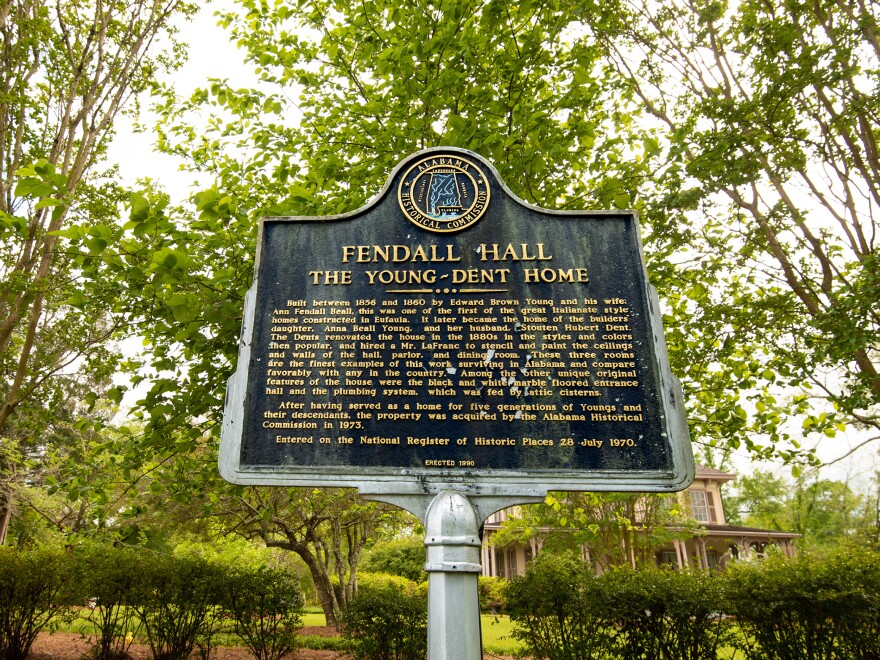
And while the sign claims the company he organized built the bridge, that bridge, spanning the Chattahoochee River, was actually designed, managed and built by a slave named Horace King, a renowned and gifted engineer, along with a large group of enslaved men.
Campbell says she'd like to see more of this information included.
"But that's because I'm a Northerner, not a Southerner," she says. She moved to the South 20 years ago from Michigan. She says most people she knows here wouldn't agree with her.
"I mean, they know," she says, glancing over at the revelers on the porch. "They know it. But [they] don't necessarily want to be reminded."
That's the difficult thing about the truth. It's just not as fun to throw parties in places where terrible things happened.
How the U.S. tells its own story is a debate raging in schools, statehouses and public squares nationwide. It has led to social movements and angry protests. But for more than a century, historical markers have largely escaped that kind of scrutiny.
With more than 180,000 of them scattered across the U.S., it's easy to see why:

Even governments don't really know what they all say. Many state officials told NPR that they have no idea what signs are in their state, what stories they tell or who owns them.
And while markers often look official, the reality is that anyone can put up a marker — more than 35,000 different groups, societies, organizations, towns, governments and individuals have. It costs a few thousand dollars to order one.
Over the past year, NPR analyzed a database crowdsourced by thousands of hobbyists, looking to uncover the patterns, errors and problems with the country's markers. The effort revealed a fractured and often confused telling of the American story, where offensive lies live with impunity, history is distorted and errors are sometimes as funny as they are strange.
Three separate states, for example, have markers that claim to be the place where anesthesia was discovered. Two states, Kentucky and Missouri, both claim to be the home of Daniel Boone's bones. Michigan and Alabama both claim to be the home of the first railroad west of the Allegheny Mountains, while Maryland and New Jersey both claim to have sent the first telegram.
Texas, on the other hand, claims to be the home of the first successful airplane flight — completed by a man who was neither of the Wright brothers.
Meanwhile, dead animals are rampant. Florida marks a dead alligator named Old Joe; California marks a dead horse — also named Old Joe. Arizona put up a marker for a donkey that drank beer. California thought it had a dead mastodon until a marker explained it was actually a dead circus elephant.
Somewhat dead humans are also popular. There are markers memorializing 14 ghosts, two witches, one vampire, a wizard and a couple who, a New Hampshire marker says, may have been abducted by aliens.
But the deeds of men are far more prevalent, even if questionable. Nevada marks a man who killed 11 people in the 1850s, even though it notes he had "few, if any redeeming traits." Arizona, on the other hand, marks the grave of a man the local town wrongly hanged for stealing a horse in 1882. It says, "He was right. We was wrong. ... Now he's gone."
There are markers to "world famous" items that few could likely pinpoint: soda water, cantaloupes, roofing slate, mustard, frozen custard, French-style cheese, beef jerky, a Santa Claus school, bourbon ball candy and dozens of others.
These are not to be outdone by the "world's best" cheddar cheese, hobby garden or seed rice, or even the "world's greatest" waterfall, harbor, gold mine, battleship, oil field, rodeo clown, roller coaster or chicken, among many others.
While some markers date back centuries, they proliferated in the 20th century, meant to capture the attention of traveling Americans who had hit the road for the first time in their new cars. The markers brought business and tourism to out-of-the-way towns. Today the roadsides and public squares of America are replete with markers that fulfill their most basic purpose, offering a simple, often sterile recounting of an interesting moment in place and time.
But over the past century, many markers have also become symbols of the country's dark and complicated past, in some cases erected not to commemorate history but to manipulate how it is told, NPR found.
From the Atlantic through the Plains, more than 270 markers describe Native Americans as "savage," "hostile" or "semi-civilized," or they use racial slurs.
In the West and Southwest, markers herald the work of missionaries and praise rangers without mentioning the violence and cultural destruction they often inflicted.
Across the South, markers honor notable men and notable houses without mentioning the forced, free labor that made both the homes and the men's wealth possible. NPR found that nearly 70% of markers that mention plantations do not mention slavery.
A fractured version of history
Particularly distorted is the Civil War, one of the single most marked topics nationwide. NPR's analysis revealed more than 500 markers that describe the Confederacy in glowing terms, vilify the Union, falsify the reasons for the war or recast Confederate soldiers as the war's true heroes.
Loading...
At least 65 markers appear to promote a racist philosophy called the Lost Cause, which claims, among other things, that Black people enjoyed being enslaved.
Many of those Confederate markers weren't written in error, NPR found. They were part of a plan.
One of them is in Tuskegee, Ala., a city that Council Member Johnny Ford describes as the "citadel of the Civil Rights Movement."
Standing in the town square, he ticks off aspects of the city's famous history: home of the Tuskegee Airmen, Tuskegee University, Booker T. Washington's National Business League. It was also the birthplace of Rosa Parks.
Close to 90% of its residents are Black, he points out.
But in the middle of the square is a stone marker depicting two Confederate flags that says: "Honor the brave. With God as our vindicator. Erected by the Daughters of the Confederacy to the Confederate soldiers of Macon County."
By Ford's reading, that marker "reflects the fight to preserve slavery," he says. "That is not a positive sign for us here in our community."
Ford and other citizens of Tuskegee have tried for decades to remove the marker, which, like many Confederate stone markers, also has a Confederate soldier on top.

But they can't. Because like thousands of markers nationwide, it was put up by a private group — in this case, the United Daughters of the Confederacy, an organization made up almost entirely of white women.
"They said they built it in honor of the Confederate dead, which we respect," Ford said. "Honor their dead, but not in a public place. Put it in some museum."
But museum exhibits were not what the United Daughters of the Confederacy was after. While the group's monument-building efforts are well known, NPR's analysis found that the United Daughters also helped erect more than 600 historical markers, far surpassing the efforts of any other Civil War heritage group.
These markers congratulate men for fighting for "the cause," "a sacred cause," "their righteous cause" and "a lost cause" and for their "patriotic devotion," "heroism unsurpassed" and "faultless valor" as they fought to break the country apart to keep men, women and children enslaved and preserve what the markers describe as their "glorious heritage."
A "fairer flag was never furled," declares one monument in Montgomery, Ala., not of the American flag, but the Confederate flag. In Sherman, Texas, a marker that the United Daughters of the Confederacy rededicated in 1996 claims Confederate soldiers' actions will "teach future generations ... Southern chivalry."
The group put up at least three markers for and memorials to Nathan Bedford Forrest, the first grand wizard of the Ku Klux Klan. It put up a marker outside Concord, N.C., to the KKK itself, though that one has been removed.
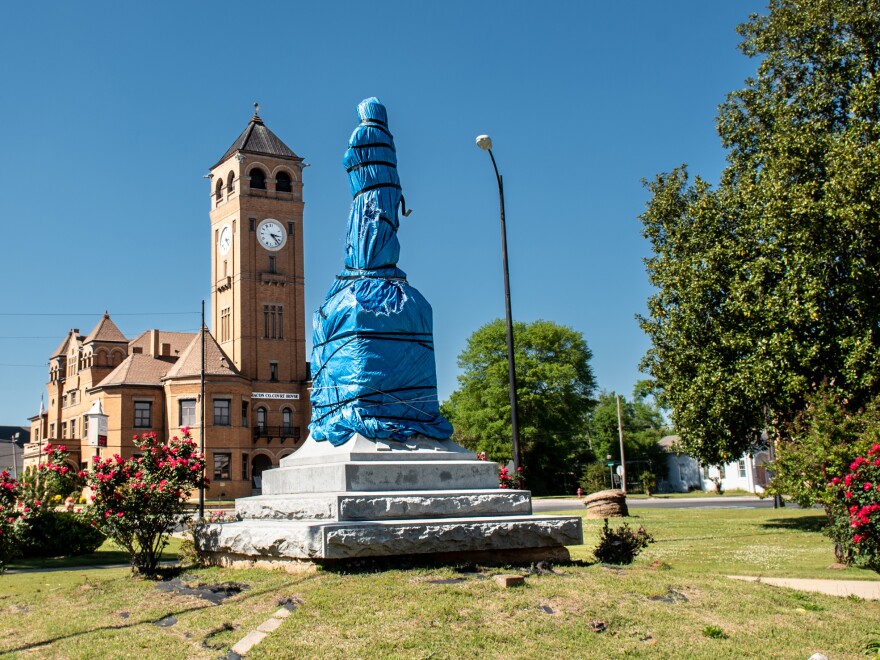
Lately, Ford and the United Daughters have been battling in court. But Ford says it's hard to know whom he's fighting.
"There are no daughters that live here," Ford said. "I think they're mostly dead. They don't pay any taxes here. Yet they want to dominate our square."
Jay Hinton, a lawyer an hour away in Montgomery who represents the group in court, told NPR in an interview that the women just want to honor dead Confederate soldiers. He acknowledged that few, if any, United Daughters live in the area.
Tax records show that the group, based in Richmond, Va., has $11 million in assets, with an annual revenue of $1 million to $2 million.
Asked why the United Daughters want to keep a marker in a place they don't live, in a town that doesn't want it, for soldiers who died 160 years ago, Hinton said it's the women's choice to make. While the 1906 town deed filed in the courthouse across the street gave the land for the marker to the United Daughters to keep as a "park for white people," Hinton says the group has always let everyone use the park.
"We're pretty comfortable, and it makes us feel like good citizens to say that we didn't discriminate, and therefore we shouldn't be made to [remove the marker]," he said. "We think we get to keep the dirt because we've been doing what we ought to be doing from a constitutional perspective."
Nationwide, markers from Civil War heritage groups like the United Daughters outnumber comparable Union groups' markers by more than 2-to-1, NPR found. Confederate hospitals and Confederate cemeteries follow a similar pattern.
In all, markers about Confederates or the Confederacy are prolific, with more than 12,000 mentions. But the words "slave" and "slavery" show up only about half as many times.
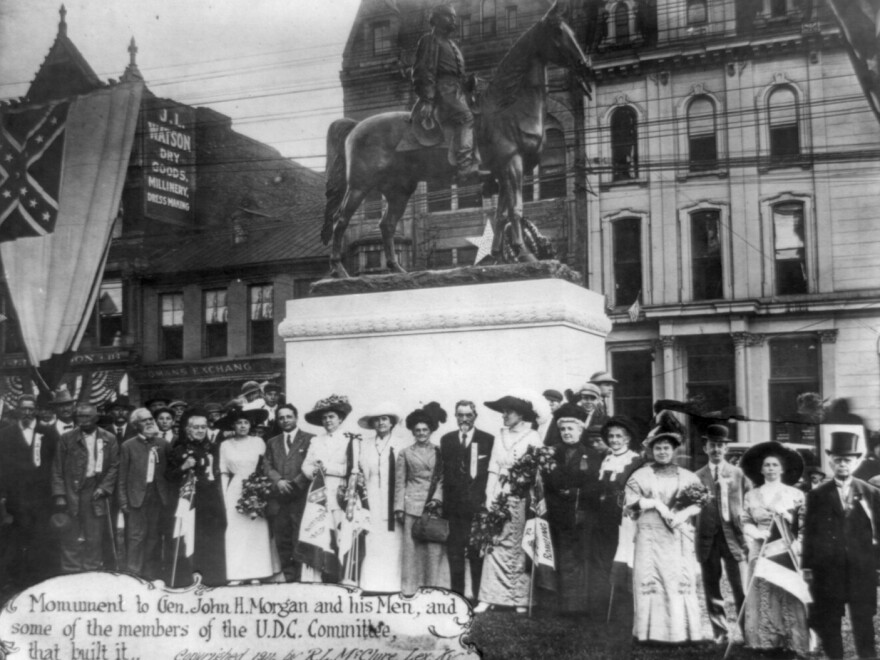
When they do, many tell a racist myth about "faithful" slaves or otherwise diminish the reality of slavery. Others markers use racist language or support white supremacy.
As groups like the United Daughters disappeared from Tuskegee and other areas, historical markers gave those organizations and their message lasting and, in many cases, national visibility. The United Daughters put up markers as far away as Arizona, New Mexico and Washington, which weren't even states at the time of the war.
Officials with the United Daughters did not respond to NPR's requests for comment. But in a statement on its website, the organization says that its markers "simply represent a memorial to our forefathers who fought bravely" and that its members have "stayed quietly in the background, never engaging in public controversy."
That's not the history NPR found.
In November 1914, the United Daughters gathered for the group's annual convention at the swanky DeSoto hotel in Savannah, Ga., to hear the keynote speaker, the group's national historian, Mildred Lewis Rutherford.
"Slavery was no disgrace," Rutherford told the women, according to records from the convention. "The Negro race should give thanks daily. ... [Slaves] were the happiest set of people on the face of the globe. ...
"In all the history of the world, no peasantry was ever better cared for, more contented or happier," she said.
As she read these words, there hadn't been a slaveholder in the U.S. for half a century. But Rutherford's speech drove toward her final point: Slaveholders needed to be defended.
"These wrongs must be righted and the Southern slaveholder defended as soon as possible," she said.
Records in state archives show the group began requiring chapters to form "memorial marker committees" and focus their efforts on fundraising.
And they haven't stopped. While many groups have begun taking down Confederate symbols, the United Daughters of the Confederacy has helped put up 47 more markers over the last two decades.
"Markers are a reflection of the people who erect them"
So it was no surprise that when Bryan Stevenson arrived in Montgomery in the 1980s, long before he gained national acclaim for his work as executive director of the Equal Justice Initiative, and went looking for markers about slavery, he couldn't find one.
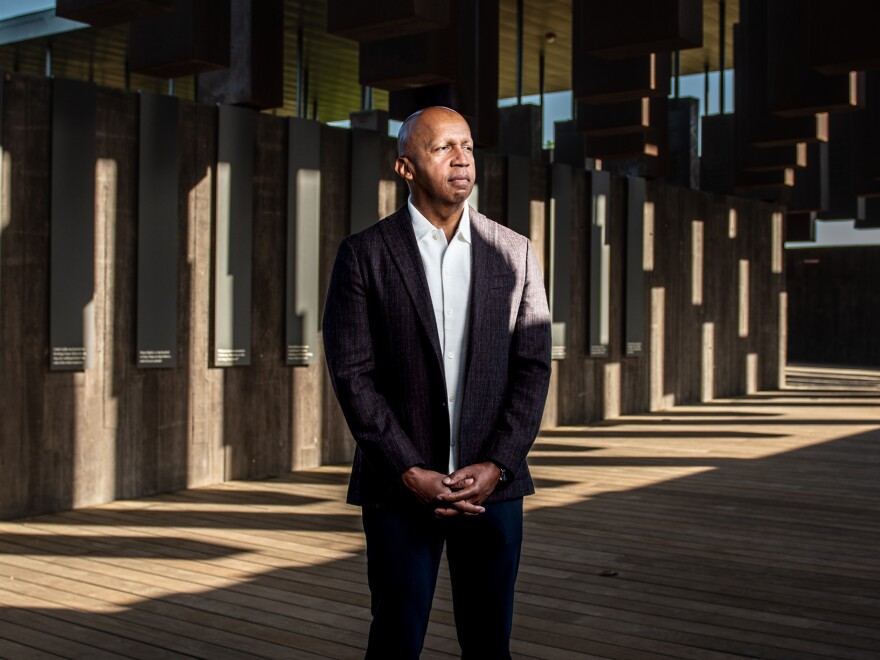
He says he counted 59 markers and monuments to the Confederacy back then as he drove around town. "Almost a preoccupation with mid-19th-century history," he recalls. "But you could not find the word 'slave,' 'slavery' or 'enslavement' anywhere in the city."
In 2013, Stevenson thought that this should change. He called up the Alabama Historical Association. He says the group sounded supportive.
"They said, 'Oh, if it's truthful, just give us the information and we'll put it up,''' Stevenson recalls. "We went to them and gave them a 60-page memo documenting the history we had investigated. And we got an email back that said, 'Yeah, your information is all true and correct, but we can't put up markers about slavery. That would be too controversial.'"
In that moment, Stevenson says, he understood what the United Daughters and other groups had figured out a century earlier: If you want to own the narrative, write it yourself.
Working with communities, Stevenson and his organization have now privately funded and erected more than a hundred markers telling the stories of lynchings in America.
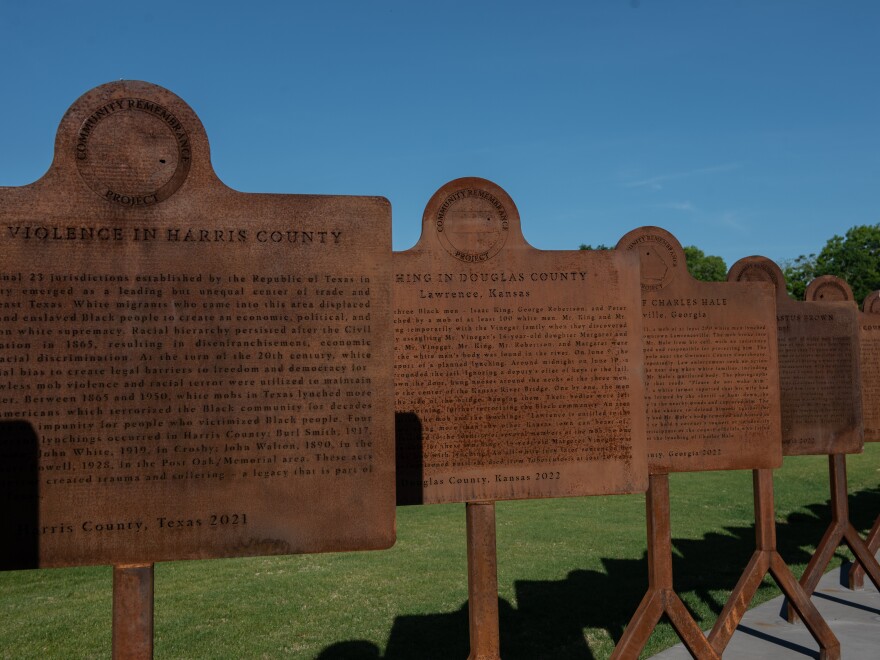
Many communities have embraced the markers. A few markers have faced hostility. Two were stolen after they went up.
They're just a small dent in the vast landscape of Confederate markers, but Stevenson says he's not looking for even numbers.
"If we are effective at telling the truth about our history," he says, "we will change our relationship to honoring things that are not honorable. We will."
The association that once turned Stevenson down now has new leadership. Scotty Kirkland took over as chairman of the association's Historical Marker Committee in 2015, and he agrees with Stevenson.
"Markers are a reflection of the people who erect them," Kirkland says. "The first markers put out by the association, it looks like they were basically done by fiat. There's no real racial diversity in these stories. There are no women marked in these early markers."
Kirkland says the group is now funding a History Revealed initiative for new stories. The association has quietly removed the Confederate flag from several markers over the past couple of years.
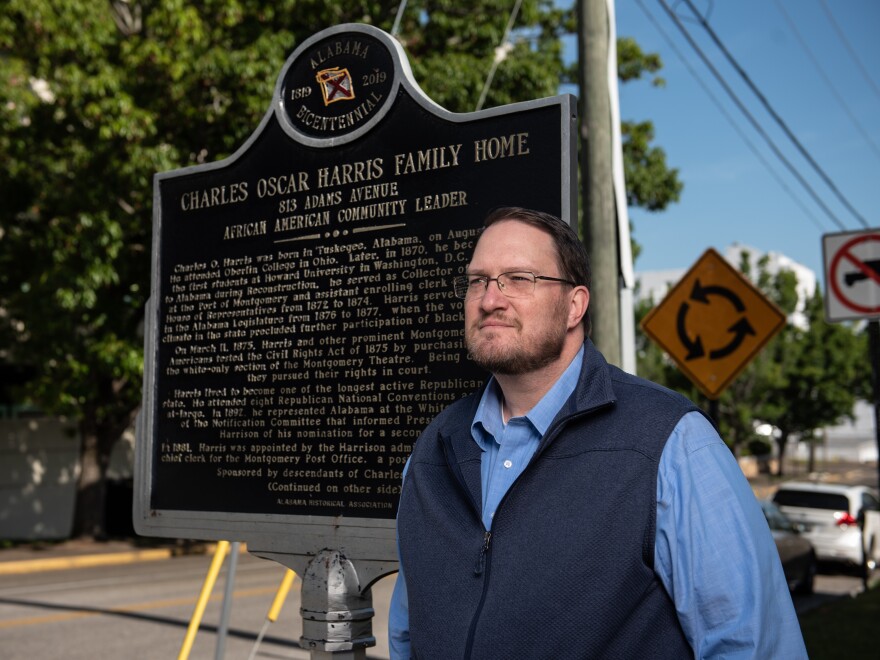
But changing the narrative can be hard, especially when old markers are rarely rewritten or removed.
Many state officials told NPR that, outside the publicly sourced database or markers they helped sponsor, they have no way to know the entirety of the markers in their states.
Only a few states, including Alabama, Pennsylvania and Minnesota, have undertaken efforts to review existing markers. In Minnesota, officials drove out to 206 markers that the state historical society either paid for or helped put up. Officials told NPR they discovered every single one of them had a problem — from grammar issues to offensive language.
Meanwhile, three states — Georgia, North Carolina and Tennessee — recently passed laws prohibiting the removal of markers on public land, making little allowance for how old, wrong, misguided, confusing or offensive they might be.
In the absence of being able to take markers down, many heritage organizations find it easier to just add new ones. In Alabama, another group, the Alabama Historical Commission — whose director controversially left in 2004, saying pro-Confederate attitudes pushed him out — now says it too is ready to move on from Confederate stories.
On a recent day, historian Theo M. Moore, who until recently was the commission's African American heritage coordinator, stood in front of one of the group's newest efforts. It's a marker to Claudette Colvin, a young Black woman who refused to give up her seat on a segregated bus before Rosa Parks.
Moore says it's "a reminder that this was a place of importance."

"We've been taught the same history, especially in the South," he says. "This is how all these stereotypes come about. What is presented all the time is negativity."
As if on cue, a neighbor, Arthur Sanders, walks across the street to tell Moore how much he likes the new marker.
"Our neighborhood disappeared, man, but that," he says, pointing to the marker, "that makes a difference because it's the start of trying to get our neighborhood back."
Moore smiles. As he gets back in his car, Moore says he knows it's just a metal sign. Most people don't even read them. But as he pulls away, he says Sanders is right: how you tell history shapes how you see the future.
And lately, he says, something else has been bothering him.
"We have all these cities named after Creek Native Americans: Wetumpka, Tuskegee, Notasulga, Loachapoka, Opelika, Tuscaloosa. ... That's all Native American, right?" he says, pausing. "Where's, you know, where's their markers?"
The Native American story
Across the country, more than 15,000 markers mention Native Americans. But the history written on them often isn't theirs.
Loading...
If there are two sides on the American frontier, NPR found the nation's historical markers come down solidly on the side of white settlers. At least 200 markers tell an eerily similar American tale: Native Americans attacked innocent white settlers for no reason.
Darla Gebhard knows this story well.
A research librarian at the Brown County Historical Society in New Ulm, Minn., she walked through a 170-year-old cemetery there, past rows of gravestones.

"I'll show you what was going through their mind if we come over here," she says. "You'll see the gravity of it."
She stops in front of dozens of graves. Their names have faded with time: John Schneider, Julius Fenske, Ernst Dietrich and many more. But the words carved underneath are clear:
"Killed by Indians, killed by Indians, killed by Indians," Gebhard says, reading each one. "You have entire families that lost their lives. This is what the reality was for them in 1862."
Gebhard is right — this was the reality for many people who lived on the Minnesota plains in the 1800s. It wasn't, however, the reality for all the people who lived here.

John Robertson, a member of the Sisseton Wahpeton Oyate tribe and a descendant of Minnesota Dakotas, stood at the edge of an expansive field in southern Minnesota known as Cansa'yapi, homeland of the Lower Sioux Indian Community in an area the federal government calls the Lower Sioux Agency.
"We're looking out over what would have been in 1862 the tall grass prairie," he says. "Even today you don't see any trees, and that's the way it would have been for 250 miles."
Three years ago, Minnesota agreed to return 114 acres of the prairie back to the tribe, acknowledging the land had never belonged to the state in the first place.
When tribal members took over the property, they also took over management of 22 state historical signs. As Robertson heads out onto a nearby path, he sums up what many of them said.

"You know, this poor settler family was massacred, and they had no defenses — the women were violated and the children were taken," he says. "I mean, that's the kind of language that are on these markers."
Robertson, who is site manager for the property, says tribal members spent a long time considering each one. And then they made a decision: to take them all down.
On a recent day, Robertson heads out on the trails to see how things are going, along with Amber Annis, who is Cheyenne River Lakota and an associate vice president with the Minnesota Historical Society. They're helping the tribe replace the signs. As a crew bangs new signs into the ground, they toss the old ones into a heap on the grass.
Robertson says it wasn't just the signs that called tribal members savages or described violent acts that troubled him. It was all the signs they weren't even on — as if the history of this place hadn't happened at all.

Annis stops in front of a stone building along the path and reads the old sign. "The [Stone Warehouse] is 43 by 23 feet, 20 feet in height, with a good substantial cellar 8 feet deep," she says. "The cellar walls are 3 feet. The first-story walls [are] 2 feet, and the second-story walls are 18 inches thick."
Robertson shakes his head. The sign, including all the dimensions, isn't wrong, he says. It's oblivious.
The warehouse was the spark that started the U.S.-Dakota wars. It's why all those settlers in the cemetery died and an untold number of Dakotas with them.
"This was the flashpoint of the actual war beginning here and the establishment of the conquered status of the Dakota nation," Robertson explains.

The Dakotas were once one of the most formidable forces in the Americas, known for their brilliant political and military strategy. But after the U.S. government took their land and prohibited them from hunting or farming, the tribe was forced to accept a treaty. One of the things it promised was food payments from the Stone Warehouse.
Except that in the summer of 1862, the government, mired in the Civil War, stopped providing food. According to letters from the time, the federal agent in charge locked the warehouse, and the main trader told the Dakotas they could "eat grass or their own dung."
Facing starvation after years of broken promises, the Dakotas declared war.
Robertson reads the beginning of the new sign, which will be written in both Dakota and English.
"The warehouse was a central scene during the outbreak of the U.S.-Dakota War in 1862," the new sign says. "Its contents were burned out during the war but the structure remained."
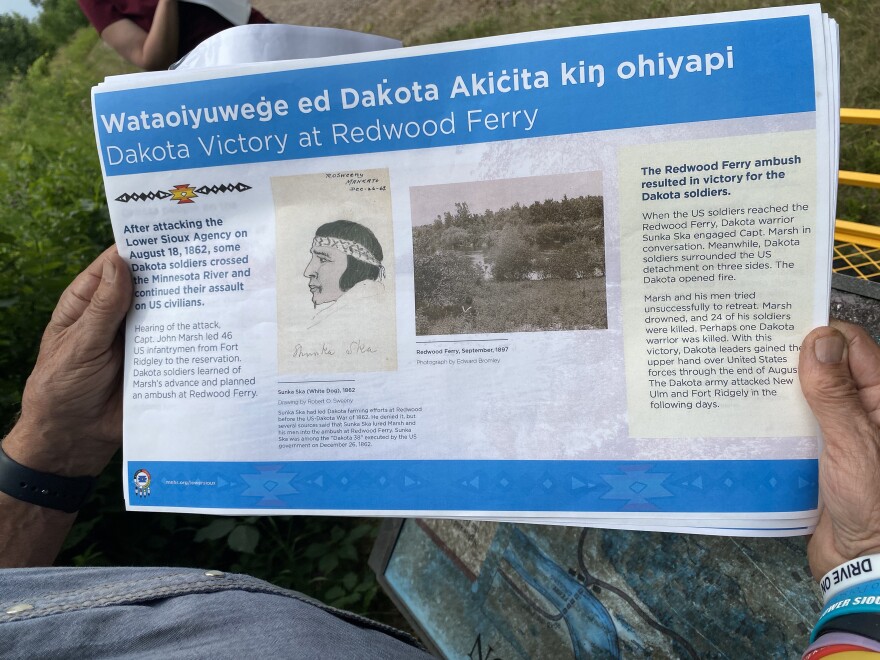
As Robertson and Annis continue down the gravel path, the new signs tell the story of the Dakotas: the arrival of the Europeans on their land, the loss of that land, the decimation of the tribe. They are plot points obscured by the old signs.
Robertson stops at one old sign that tells of a boat landing that it says "was perhaps the busiest spot at the agency which brought steamboats, supplies and even tourists here in the 1850s."
These tourists, it says, enjoyed the "sights and sounds" of the blacksmith shop and sawmill.
But that's not the whole story. Newspaper advertisements from 1858 show that tour guides promised tourists that they could watch Dakota warriors in traditional dress collect food payments.

"Being Native, you grow up, wherever you go, you already know it's going to be something that's not true," Annis says. "It's harmful. I have two daughters. I think about them a lot. When they come to places like this, they will be able to see themselves in different ways."
Some of the new signs detail the Dakotas' military successes, including a victory over a company of Fort Ridgely soldiers near the river.
But Robertson and Annis know how the story ends. The federal government marshaled hundreds of soldiers until the Dakotas surrendered and then hanged 38 of them and removed the rest of the tribe from Minnesota. Robertson says he's not trying to change that history.
He's trying to explain why it mattered.
"Hopefully when you read it, the sign is going to speak to you in a different and continuing way," Robertson says. "That's the goal of the signage. Then you would say, 'I heard something about that,' or 'I want to know more about that.' And it's going to be alive for you. I hope."

Throughout the rest of the state, though, the signs speak the same way they did a hundred years ago.
On a grassy median in a busy New Ulm intersection, one marker describes the "depredations of the savages" who "massacred nearly all the whites."
Another, using a racial slur, claims Native Americans "had no pity for women or children." In Morton, a marker praises the "brave, faithful ... loyal Indians who saved the lives of white people." Rarely are Native Americans referred to by name.
On the New Ulm courthouse lawn, a marker congratulates the settlers for creating New Ulm.
"It's paying homage to the pioneers who founded the territory of Minnesota," says Gebhard, the Brown County historian.
Asked whether the Dakotas could say they founded the area, Gebhard says, "Oh, absolutely. And so if the Dakotas put up a marker saying this is our homeland, they would be absolutely correct in doing so."

But this idea of dueling markers — that stories can be told two ways, should be told in two ways — is problematic for historians.
"It doesn't do justice to the idea that we want to tell a full and complete story," says Chantel Rodriguez, senior public historian with the Minnesota Historical Society, which is reviewing the state's markers. "That means weaving together the perspectives. What if you only see one marker and not the other? The reason why we feel the need to have separate markers is because we want to retain the original story."
The courageous stories of both settler families and Native American families can be told together. But they rarely are.
On the back of the courthouse pioneer marker in New Ulm is the name of every town resident who died in the U.S.-Dakota wars fighting for their families. There's no marker in the database that lists the names of the Dakotas who died fighting for theirs.
Gebhard said a member of the Dakotas asked her about this once.
"I was doing a downtown tour with a Dakota person, and she asked me, 'What do people in New Ulm think about the Dakota war?'" Gebhard recalls. "And I said, 'They don't.' And then this person said, 'Well, why is that?' And I said, 'Because we won.'"

A murder shrouded in secrecy
When it comes to the nation's history, though, exactly who "we" is, is no longer clear. Where once markers might have merely entertained travelers, by sheer volume over the course of a century they have become, instead, an entire nation's history book, its first social media campaign.
They spread hate, and joy. And they have unlocked secrets, even ones from a long-forgotten murder on the edge of a two-lane highway near Gadsden, Alabama.
A local from the area, Jerry Smith, pulled his car onto U.S. 11. Asked what Gadsden is known for, he paused.
"Not a damn thing," he said.
But that's not true, at least not anymore. Just up this road is a new historical marker saying otherwise. Smith was just a teenager when it all started in 1963, as he drove down this highway in his green Chevrolet Corvair.
That's when he saw a strange man walking down the road, with a sign over his body, pulling a wagon. Smith knew he was what Alabama's then-governor, George Wallace, had warned about.
"His favorite term was 'outside agitators,'" Smith says of Wallace. "If they would leave us alone in Alabama, everything is fine. But these 'outside agitators' are fanning racial fire. Well, it was George Wallace that was fanning racial fire. But, you know, early on I might have been a little too dumb to know that."
As he slowed down to pass the man, Smith was surprised to see that he looked just like any other guy. The two locked eyes. Smith thinks the man may have even smiled a little.
So when, just a couple of hours later, someone shot the man point-blank in the face and throat and left his body on the side of the road, Smith was deeply troubled. And yet, no one dared talk about it.
"There was a lot of people that thought this guy, walking down the road pulling a buggy, we didn't need him," Smith remembers. "And there was some people that [said] he's not fit for being here. We oughta kill him, you know?"
The man was William Lewis Moore, a white postal worker from Baltimore, on a one-man protest march. His murder has never been solved.
For years, it bothered Smith. What bothered him more, though, was the silence.
"The years passed by — other things happened," Smith says. "This lost significance in the eyes of Alabamians."

And then one day, as he was driving, it dawned on Smith what he could do about it.
"I thought, 'At least we ought to have a plaque,'" he says.
At first, people told him not to do it. Let the past lie, they said. One person even messaged him on Facebook saying that it might be dangerous.
But Smith kept talking about it, calling people. And then one afternoon, he went and made a speech in front of the county commission, and the commissioners voted unanimously to pay for it.
On the day it was unveiled, several dozen people came out in the rain to see it.
"William Lewis Moore ... was assassinated at this location during a 400-mile protest march from Chattanooga, Tennessee, to Jackson, Mississippi," reads the marker, planted in a gravel patch between the road and the train tracks. Someone left flowers at its base.
Then, something strange happened. People in the community started talking openly about the murder. Moore's death was no longer a community secret. It was history — public history — right there on the side of the road.
And now at the diner, the town museum, even the local sheriff's office, lots of people will tell you details that many people knew: that Moore stopped at a grocery store along the road, that he got into a confrontation with the store manager in the parking lot, that the manager's name was Floyd Simpson.
"He's the one everyone thought did it, thinks did it," says Johnny Grant, the assistant sheriff for Etowah County, who has spent 48 years in law enforcement here, speaking publicly about Simpson for the first time.
Grant hadn't joined the sheriff's office yet at the time of the murder, but some of his closest friends were on duty that night. Grant says they all suspected Simpson.
He says he even quietly reinvestigated the case years ago, when he became chief investigator, to see whether more could be done. But Simpson was already dead. He died 26 years ago.
The idea of Simpson as suspect wasn't too much of a stretch. There was the public confrontation, for one thing. And Grant says police records show Simpson was in the Ku Klux Klan.
Plus, a witness saw what looked like Simpson's Buick sitting on the side of the road just before the murder. And finally, a state forensic technician said he believed the bullet matched Simpson's gun.
But the grand jury declined to indict Simpson, and people in the town put the whole thing behind them.

"The evidence, to me, I would have charged him," Grant says, "and I would have been able to charge him now, however many years later. But they took it to the grand jury, and the grand jury refused to indict him."
Today, Grant is also an Etowah County commissioner. When Jerry Smith came forward one day asking for marker money, Grant quickly voted yes. He says he wanted the story told.
"That was just hate," Grant says of the murder.
He calls the marker one of the best things the county has done.
"It will always be a black eye to Etowah County," Grant says of the killing. "I just hope as law enforcement they did everything they could to solve it."
Now, that black eye is on the side of the road for everyone to see, part of the American story. Moore's marker and tens of thousands of others like it are all pieces of that story, staked into the ground to mark a place in time and make it permanent.
But, like the story of William Lewis Moore's death, how the nation sees its past keeps changing anyway.
Audio for this story was produced by Graham Smith. It was edited by Robert Little. Additional reporting by Tilda Wilson and Tirzah Christopher. Design, development and illustrations by Connie Hanzhang Jin. Graphics editing by Alyson Hurt. Digital project coordination by Desiree F. Hicks. Photo editing by Emily Bogle. Copy editing by Preeti Aroon.
Copyright 2025 NPR





